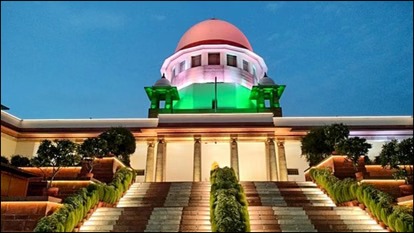Suneet Kumar, J. - Heard learned counsel for the parties.
By means of instant writ petition, petitioner is seeking following relief :
"(1) Issue a writ, order or direction in the nature mandamus commanding to the respondent authorities shall not interfere in the liberty of the petitioners to life as husband and wife of their living in relationship, it is further prayed that this Hon''ble Court may graciously be pleased to guardian of the petitioners or any causes disturbance to the peaceful living of petitioners or in any way harass or humiliated the concerned respondent nos. 1, 2 and 3 shall provided immediate protection to them."
2. It is sought to be urged by learned counsel for the petitioner that the first petitioner is already married to one Sanjay Kumar solemnized on 30 May 2016, which according to the first petitioner was against her wishes. The petitioners, who were having live in-relationship for the past five years, have eloped and they intend to marry, therefore, seek protection.
3. It is sought to be urged on behalf of the petitioners that though the first petitioner is already married and her marriage subsist in law, however, the petitioners have a right to live in-relationship, therefore, are entitled to protection.
4. In my opinion, the contention is of learned counsel for the petitioner is misconceived for the reason that it is admitted that the first petitioner is already married and this fact is also known to the second petitioner, as such, the relationship is adulterous for which the second petitioner can be prosecuted. Under law relationship ''in the nature of marriage'' is recognised and not a simpliciter live-in relationship as held by the Supreme Court in Indra Sharma v. V.K.V. Sharma, (2013) 10 SCC 48, wherein the court observed as follows. Paragraphs 37, 38, 39 and 53 are reproduced :-
"37. Distinction between the relationship in the nature of marriage and marital relationship has to be noted first. Relationship of marriage continues, notwithstanding the fact that there are differences of opinions, marital unrest etc., even if they are not sharing a shared household, being based on law. But live-in-relationship is purely an arrangement between the parties unlike, a legal marriage. Once a party to a live-in-relationship determines that he/she does not wish to live in such a relationship, that relationship comes to an end. Further, in a relationship in the nature of marriage, the party asserting the existence of the relationship, at any stage or at any point of time, must positively prove the existence of the identifying characteristics of that relationship, since the legislature has used the expression "in the nature of".
38. Reference to certain situations, in which the relationship between an aggrieved person referred to in Section 2(a) and the respondent referred to in Section 2(q) of the DV Act, would or would not amount to a relationship in the nature of marriage, would be apposite. Following are some of the categories of cases which are only illustrative:
38.1.(a) Domestic relationship between an unmarried adult woman and an unmarried adult male : Relationship between an unmarried adult woman and an unmarried adult male who lived or, at any point of time lived together in a shared household, will fall under the definition of Section 2(f) of the DV Act and in case, there is any domestic violence, the same will fall under Section 3 of the DV Act and the aggrieved person can always seek reliefs provided under Chapter IV of the DV Act.
38.2.(b) Domestic relationship between an unmarried woman and a married adult male : Situations may arise when an unmarried adult women knowingly enters into a relationship with a married adult male. The question is whether such a relationship is a relationship "in the nature of marriage" so as to fall within the definition of Section 2(f) of the DV Act.
38.3.(c) Domestic relationship between a married adult woman and an unmarried adult male : Situations may also arise where an adult married woman, knowingly enters into a relationship with an unmarried adult male, the question is whether such a relationship would fall within the expression relationship "in the nature of marriage".
38.4.(d) Domestic relationship between an unmarried woman unknowingly enters into a relationship with a married adult male : An unmarried woman unknowingly enters into a relationship with a married adult male, may, in a given situation, fall within the definition of Section 2(f) of the DV Act and such a relationship may be a relationship in the "nature of marriage", so far as the aggrieved person is concerned.
38.4.(e) Domestic relationship between same sex partners (Gay and Lesbians): DV Act does not recognise such a relationship and that relationship cannot be termed as a relationship in the nature of marriage under the Act. Legislatures in some countries, like the Interpretation Act, 1984 (Western Australia), the Interpretation Act, 1999 (New Zealand), the Domestic Violence Act, 1998 (South Africa), the Domestic Violence, Crime and Victims Act, 2004 (U.K.), have recognised the relationship between the same sex couples and have brought these relationships into the definition of Domestic relationship.
39. Section 2(f) of the DV Act though uses the expression "two persons", the expression "aggrieved person" under Section 2(a) takes in only "woman", hence, the Act does not recognise the relationship of same sex (gay or lesbian) and, hence, any act, omission, commission or conduct of any of the parties, would not lead to domestic violence, entitling any relief under the DV Act.
53. Live-in relationship, as such, as already indicated, is a relationship which has not been socially accepted in India, unlike many other countries. In Lata Singh v. State of U.P., (2006) 5 SCC 475 it was observed that a live-in relationship between two consenting adults of heterosexual sex does not amount to any offence even though it may be perceived as immoral. However, in order to provide a remedy in Civil Law for protection of women, from being victims of such relationship, and to prevent the occurrence of domestic violence in the society, first time in India, the DV Act has been enacted to cover the couple having relationship in the nature of marriage, persons related by consanguinity, marriages etc. We have few other legislations also where reliefs have been provided to woman placed in certain vulnerable situations."
5. In the facts of the case before the Supreme Court the appellant (lady) had entered into the relationship knowing fully well that the man is married and therefore the Court declined to grant her any relief holding that the relationship would not be a relationship in the nature of marriage.
6. The ratio of Indra Sharma squarely applies on the facts of the present case for the reason it is admitted and pleaded in the writ petition that the second petitioner entered into a relationship with the first petitioner who is married and her marriage has not been dissolved by any competent court as on date, therefore, such a relationship cannot be granted any protection.
7. For the reasons and law stated herein above, the petition being devoid of merit is accordingly dismissed.

